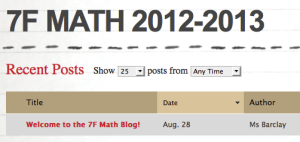One Step at a Time
September 20, 2012 Leave a comment
It was a very busy summer and just now have I had a chance to re-read my past post on my goals for this year. Luckily, I’ve been moving forward with most of these in the first few weeks of the year. Here are a few things that I’m working toward and items where I might need some help from the Ed Tech community will be highlighted in red. If you know someone who might be able to help me, please forward this along. Thanks!
 Blogging for Grade 7/8 Math Problem Solving
Blogging for Grade 7/8 Math Problem Solving
Starting next week, I will be introducing my students to blogging. This will be our main environment for presenting solutions to a variety of open-ended problem solving tasks this year. I am hoping to encourage conversation about problem solving methods and strategies among my students. I will also encourage them to solve their problems using a wide variety of technologies – photos of hand-written solutions, thorough typed solutions and explanations, videos… whatever! I have chosen kidblog as the blogging platform for my class, although there are several great options out there.
We will spend the first few weeks solving problems, presenting thorough solutions and learning to comment on others’ solutions in appropriate ways. Once the boys have learned these skills, I hope to make some connections and have my students begin to read and comment on other blogs from around the world. Ideally, I would like to pair up with another teacher who is using blogging (or considering it) for a similar purpose in math. Our students could then comment on and receive comments from others around the world.
Preparing for 1-to-1
A year from now we will just be settling into a new educational model. All students at my school will have a device of their own. iPads from SK-2, a mix of iPads and laptops in grade 3, and laptops from grades 4-7. This is going to be quite the change for our teachers and students, but everyone around the school seems to be planning for it already – and everyone is excited. We did a lot of preparation for this last year and it is seeming to pay off as I regularly hear, “when they have laptops next year…” Now we need to put the nitty-gritty in place – storage, charging, transport. One item I would be interested in hearing about from those who have been through this process is screen monitoring software. Some teachers have requested a way to monitor what is on students’ screens at any particular time. My inclination is to tell them to get up and walk around. However, we have been asked to investigate our options. The way our network is configured limits some of our options and I would be curious to hear from those in schools where screen monitoring is available – do you use it? If so, when and how often? What is the main purpose? If you did not have that tool, what would you be unable to do? Thanks for any and all input.
Student Digital Portfolios
Last year with the launch of Google Apps at our school, I began to use Google Sites with my grade 6 & 7 students for developing personal portfolios. It was limited last year to mainly an art portfolio, but our art teacher was very enthusiastic and every student ended up with their year’s worth of work on their site with reflections and descriptions. For last year’s grade 6 students, we have just added their grade 7 page to their portfolios and it is so fulfilling to see these portfolios really begin to take shape over multiple years. There is more interest in it this year from other teachers who are also wanting the boys to use the portfolio for storing and reflecting on work or learning strategies. It’s exciting! We are very lucky to have the opportunity to present our work from last year at this year’s ECOO conference in Toronto. I am looking forward to sharing and learning from others who attend our session. Unfortunately, we’ve been scheduled to present during the last time slot on the last day. Please – stick it out if you’re going and come see some of our student sites!
Just with these few things, it’s shaping up to be a busy year… time to get back to work!
